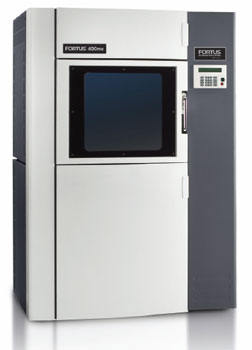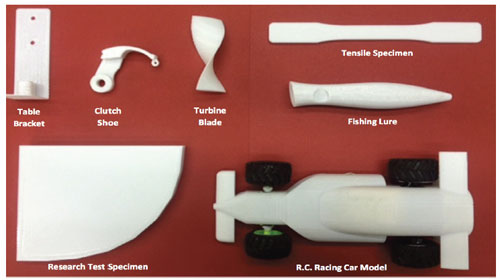
 Additive manufacturing (AM), commonly known as “3D printing,” is one of the most exciting and potentially transformative technologies in use today. This process, which allows users to fabricate three dimensional objects from computer generated 3D models, is becoming rapidly adopted by organisations and individuals worldwide. It is estimated by 2016 that the AM market will be worth US$3.1 billion and US$5.2 billion by 2020. Additive manufacturing (AM), commonly known as “3D printing,” is one of the most exciting and potentially transformative technologies in use today. This process, which allows users to fabricate three dimensional objects from computer generated 3D models, is becoming rapidly adopted by organisations and individuals worldwide. It is estimated by 2016 that the AM market will be worth US$3.1 billion and US$5.2 billion by 2020.
Leading online technology publication TechRepublic, says 3D printing “is destined to transform almost every major industry and change the way we live, work, and play in the future.” In a more succinct summation of its impact, the Harvard Business Review headlined an article on the topic “3D Printing Will Change the World.”
And what of Trinidad and Tobago?
Faced with an increasingly pressing need to diversify the economy and energise sectors outside of oil and gas, manufacturing has for some time now been seen as an industry with great potential. Guided by this drive to support the development of local manufacturing, the Department of Mechanical Engineering and Manufacturing of the Faculty of Engineering (MME) at The UWI St Augustine Campus, has acquired a 3D printer, specifically a fused deposition modeling (FDM) machine.
The goal is to give regional manufacturing a competitive boost by encouraging the adoption of new technologies and to educate a new generation of manufacturing engineers and innovators skilled in their use. And the acquisition of the FDM machine is another stage in an ongoing process designed not so much to transform our existing manufacturing industry as it is to giving it the vital injection needed to vault onto the global marketplace.
The future of manufacturing
“We should be innovative. We should be creative. We should promote entrepreneurship,” says Dr. Boppana V. Chowdary, Programme Coordinator, Manufacturing Engineering, at UWI, in his office in the MME Department.
A native of India, not only is Dr. Chowdary UWI St Augustine’s chief evangelist and strategist for local manufacturing, he may be the expert most singularly focused on the topic in Trinidad and Tobago.
“My philosophy is very simple,” he says. “For any nation, if you have a strong manufacturing base, that is the backbone of your country. That can sustain your forever, despite what is happening in other sectors. Manufacturing is evergreen.”
Since joining the Faculty of Engineering in 2003, Dr. Chowdary has worked to carve out a space for manufacturing engineering on the campus, with the goal of creating a university-centred national and regional resource for the development of the manufacturing industry. The purchase of the new FDM machine by the Faculty was a result of his advocacy.
The 3D printer, a Fortus 400mc manufactured by Stratasys, cost approximately TT$1.25 million. It is a rapid prototyping (RP) technology, meaning that it can create 3D objects primarily for prototyping purposes (for example, plastic models of machine parts) although in some cases it can produce functional models. There are 3D printers that can produce a wide array of fully functional items but these models can cost up to three and four times the price of UWI’s new FDM machine.

Nevertheless, Dr. Chowdary has identified several potential opportunities for functional models that can be manufactured by the machine, several of which are on display at the department’s Computer Numerical Control (CNC) Laboratory (the lab houses computer controlled manufacturing machines). Many of them are student projects. These include highly complex medical models like human skulls and other bones, smartphone faces and even functional spanners.
“Although we can only manufacture certain functional items, we can still perform a lot of miracles,” Dr. Chowdary explained. “We are dependent on markets in the US and Europe for so many items. And an item that costs $10 we are paying almost $100 per item, as well as the four weeks for delivery. The medical models used in instructing students cost hundreds of thousands of dollars; cadavers are not readily available. Why can’t we make them ourselves?”
But even as a prototyping technology, the FDM machine can generate economy activity and meet some demand for manufactured goods. We live in a world of machines. Indeed, tool use is one of the characteristics that mark us as a species. In our daily lives we either use or come into contact with so many implements and devices that we take their function for granted. But many of them and their components are imported. Without violating intellectual property rights, 3D scanning and printing technology allows us to very easily model and manufacture prototypes for most items. And from these prototypes they can be mass produced.
3D printing and competitiveness
When speaking to members of the Faculty of Engineering concerned with innovation and competitiveness, the importance of “time” is a consistent theme.
“Time is the key,” says Professor Brian Copeland, Dean of the Faculty of Engineering. “You have to get there fast. You do your utmost to get it done to the highest possible standard within the window of opportunity.”
This is one of the main reasons that 3D printing is so compelling to Dr. Chowdary and the MME Department. 3D printers are an “on-demand” technology. For example, a patient with a bone fracture could potentially have the bone scanned, have the scan converted into a 3D image, have that image printed, and provide him with the necessary prosthetic before he leaves the doctor’s office. This is impossible with conventional manufacturing since a prosthetic designed specifically for a patient’s shape, weight and structure would require iterations of models and trials.
Dr. Chowdary says, “When we need to compete internationally, time counts. If we are behind, someone else will take our position.”
 Having committed himself to the cause of manufacturing engineering in the region, Dr. Chowdary is an almost exact blend of urgency and patience. In his almost 12 years with the faculty he has seen the progress of manufacturing engineering achieve successes and suffer setbacks. With the support of the Faculty of Engineering, the broader university and even the Government of Trinidad and Tobago, he has overseen the restructuring of the CNC Laboratory; the acquisition of equipment like various CNC machines such as mills, lathes and routers; a 3D scanner and now the 3D FORTUS printer. Having committed himself to the cause of manufacturing engineering in the region, Dr. Chowdary is an almost exact blend of urgency and patience. In his almost 12 years with the faculty he has seen the progress of manufacturing engineering achieve successes and suffer setbacks. With the support of the Faculty of Engineering, the broader university and even the Government of Trinidad and Tobago, he has overseen the restructuring of the CNC Laboratory; the acquisition of equipment like various CNC machines such as mills, lathes and routers; a 3D scanner and now the 3D FORTUS printer.
In September 2014 the faculty will launch its restructured MSc in Manufacturing Engineering and Management, a research degree programme for both full and part-time students that stresses linkages between the university and industry. The programme, Dr. Chowdary explains, was developed in part to meet the needs of the manufacturing sector:
“We are in touch with the industry since 2004 and continuously survey the local manufacturing industry operations to find out how we could more effectively support them. What we found, especially among small-scale participants, was that they wanted to implement more advanced and effective technology solutions but could not afford to send their personnel abroad for training. Thus there is a need for trained manufacturing engineers and managers and UWI should work to meet that need.”
It’s been challenging. The discipline of engineering is very much tied to oil and gas, by far Trinidad and Tobago’s most dynamic sector. This has lead to inertia in building new courses of study in areas like manufacturing engineering and management which are important for diversification.
“Initially, some people were not enthusiastic,” Dr. Chowdary says. “From their perspective they are right. The country has had a successful oil and gas sector for 20 to 30 years. These are the jobs students are looking for when they graduate. ‘Why struggle with manufacturing?’ they ask me.”
He says, “I tell them that approach is not right. Oil and gas are finite resources. What happens when they are exhausted? Don’t expect overnight that God will come and save the economy. We have to come up with ways and means to generate economic activity. We have to take entrepreneurial kinds of approaches.”
Dr. Chowdary is undeterred, and with the MSc programme and the addition of the 3D scanner and FDM machine to the CNC laboratory, manufacturing engineering has made concrete progress within the university. Currently he is developing plans to target niche areas for manufacturing, such as components for the agriculture, automobile and aerospace industry.
“We are taking small steps, he says, “looking for that area where we can manufacture a competitive product. I want to show the strength of this university and this department, as well as the people of T&T.”
And to truly make it happen, manufacturing engineering’s number one advocate cannot do it alone. If, as is often stated, diversification is urgent and manufacturing is viable, the Department of MME within the Faculty of Engineering at UWI St Augustine is developing a powerful tool for future prosperity. And as any tool it has to be used.
“This is my purpose. This is my aim,” says Dr. Chowdary. “If the stakeholders are ready I am more than willing to share my expertise so that we can make it happen.”
The FDM Process
FDM technology forms 3D objects (specifically rapid prototypes) from computer generated models. A temperature controlled head extrudes from a thermoplastic wire spool that builds an item, 2D layer by 2D layer, until it forms a complete 3D object.
In general, the manufacturing process can be broken into five stages.
- Create a 3D solid part model through a computer aided design (CAD) package.
- Export the 3D model to the FDM software in stereo lithography (STL) format.
- Slice the STL model into 2-dimensional (2D) sections or contours.
- The 3D printer (FDM) builds the prototype using thermoplastic by applying 2D layer upon layer.
- Post-process the prototype by cleaning, curing and finishing.
|





